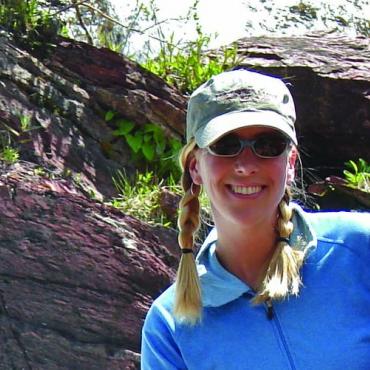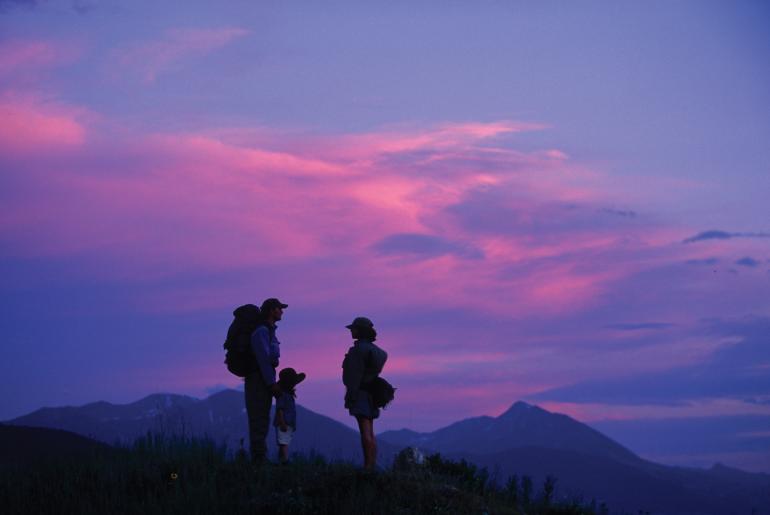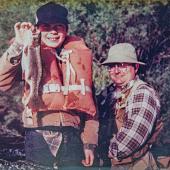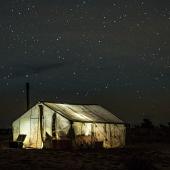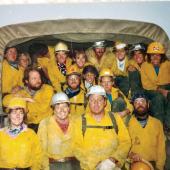Natural Connection
Learning and growing in nature.
Many of us have memories of playing outside as children—my brother and I, for example, loved the old oak tree near our house. Its large limbs bent down to the ground; we’d scoot through the leaves to the secret interior where we could be whoever we wanted. The tree was at various times a house, a jungle, a fort, a secret parent-proof hideaway, and a space ship. I don’t know why, but Scott and I never seemed to bicker inside those tree limbs.
As we climbed on the branches or picked through the leaf litter for bugs, we were participating in what is now called “unstructured play.” Studies show that by interacting with the natural world we were lowering our stress levels, increasing our imaginations, becoming fitter and leaner, developing stronger immune systems, less likely to experience the symptoms of ADD or ADHD, and gaining a greater respect for ourselves, others, and the environment. Plus, we were out of our mom’s hair for a few hours.
Those are a lot of benefits to come from a tree, but more and more scientists, doctors, and parents are learning that contact with nature is needed for the development of a healthy child (and a healthy adult, for that matter). Today’s children are often “plugged in” to computers, televisions, video games, and other media—and unplugged from the natural world.
Richard Louv’s book, Last Child in the Woods, coins the term “nature deficit disorder” to describe this child/nature disconnect. “Increasingly, nature is something to watch, to consume, to wear—to ignore,” he writes. Today’s kids are more globally linked—they can talk with authority about the Amazonian rainforest and melting polar ice caps—and less locally linked—many Bozeman kids have never been to Yellowstone National Park.
Why aren’t kids playing outside the way their parents did when they were younger? “I think a lot of it has to do with families being downright busy,” says Jamie Saitta, Recreation Program Manager for the City of Bozeman. “A lot of families are working families and they have little time to get out and be active,” she says.
Even if parents do have the time, “they may not have the skills to get outside,” adds Saitta. But backpacking, canoeing, or rock-climbing expertise isn’t required to send a child into the back yard or to the park to play. All that is needed is open space and imagination.
Another reason kids may spend more time indoors is that parents aren’t comfortable sending their children out into the world alone—even if it’s just down the street. A mother playing with her kids at Sacajawea Park in Livingston commented, “The world is scary today; I would never let my kids go somewhere without an adult. They don’t even walk to school anymore; I drive them.”
Though parents may feel safer having their children in front of the computer rather than running around at the park unattended or walking to school alone, studies show it just isn’t healthy. A Kaiser Family Foundation study found that the average American child spends 44 hours per week staring at some kind of electronic screen—that’s more than a typical adult’s workweek, doing exactly what most adults would rather not be doing.
Not only are kids spending more time plugged in at home, they are spending less time in outdoor recess in order to prepare for mandatory testing instead. Saitta notes, “With childhood obesity rates still skyrocketing, it’s important to get kids habituated to playing outside while they’re still young.”
A special report in the New England Journal of Medicine states that after years of life expectancy increasing for Americans, it may now be on the decline due to obesity. But obesity isn’t the only situation that could be improved with an increase in the exposure to nature.
Louv writes, “children need nature for the healthy development of their senses, and, therefore for learning and creativity.” The plugged-in world only engages two senses—sight and hearing—leaving out touch, smell, and taste. Nature is a three-dimensional world, filled with sights, sounds, smells, textures, and—for the careful explorer—taste.
“Kids need direct experiences such as playing in the dirt, looking under rocks, or collecting macroinvertebrates,” notes outdoor educator Krista Wright. “The indirect learning experiences they get from computers may have some benefits, but being outside and connecting with the natural world leads to so many more.”
Nature doesn’t have to mean “wilderness.” Direct experiences can be had in a corner of the backyard, at the creek in Bogert Park or the sage and wildflower slopes on Peets Hill. As long as children are playing outside—without parents watching their every move and dictating their play—they are gaining the benefits of connecting with nature.
Parents want to improve the quality of life for their children. They want their kids to have more than they had, but sometimes giving more—more computer time, more structured “learning experiences,” more Dinosaur Train—means less time building dams in a creek or stringing flowers into a wreath. These types of experiences are necessary for healthy kids to become healthy adults. Playing pirate in an oak tree can lead to creativity, inquisitiveness, and better health. And in the rich natural environment that is southwest Montana, parents have the opportunity to ensure their children are exposed to unfettered free-time outside in natural places.


